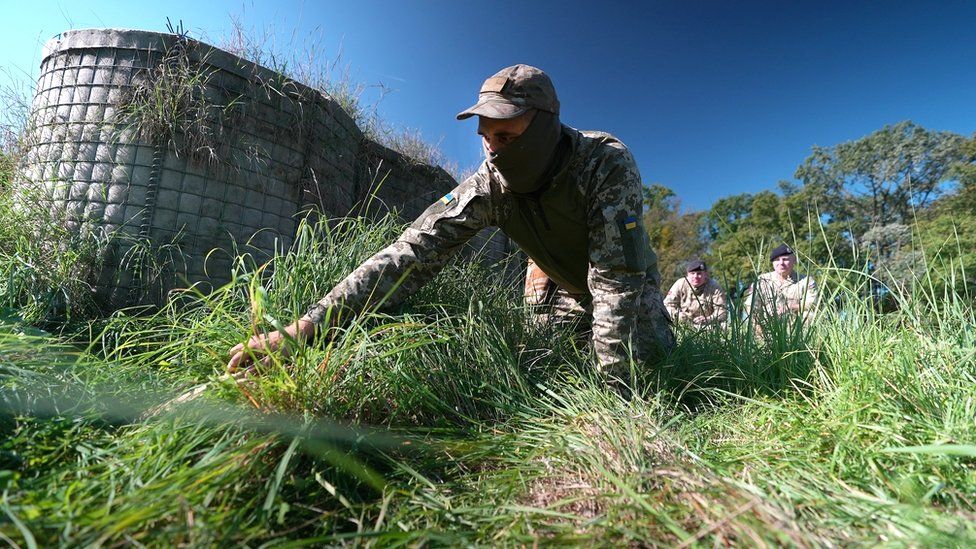-

-
-
Loading

Loading

Specialized bomb disposal teams from the British military are providing training to Ukrainian engineers in order to clear Russian minefields. Ukraine is currently the most heavily mined country in the world, which is hindering the progress of the Ukrainian military. The training, requested specifically by Ukraine, is being conducted by British Army sappers who have faced similar obstacles in Afghanistan. This article by the BBC provides an exclusive visit to the military base in Poland where the training is taking place. Most of the Ukrainian engineers, like Denys, already have experience and have been battle-hardened. Denys volunteered to fight the day after Russia's full-scale invasion began in February 2022. This visit to Poland is his first time leaving Ukraine since 2021, and the first time he has seen passenger jets flying overhead in almost two years. Denys describes Explosive Ordnance Disposal (EOD) as the most dangerous job in the world and emphasizes the need for more sappers, as Ukraine currently has a shortage of them. He confirms that he has lost friends while doing this dangerous work. Denys expresses gratitude for the help provided by his British counterparts, but emphasizes that Ukraine still requires additional Western assistance and equipment to clear the Russian minefields. He believes that even if the war were to end tomorrow, it would take hundreds of years to remove all the mines that have been laid. Russia has been manufacturing and dispersing mines in Ukraine on an extensive scale. The minefields now cover an area the size of Florida, with an estimated depth of up to 10km (6.2 miles). A single square meter can contain up to five explosives. At the military base in Poland, the British training team has buried and booby-trapped over 20 dummy devices for testing purposes. The devices include anti-tank mines, anti-personnel mines, bounding mines, and grenades attached to trip wires. Additionally, there are other hidden mines designed to harm individuals, mines triggered by vibration, and mines capable of turning on and off to evade detection. Ihor, who has been a sapper for four years, has already lost over 10 members of his team. He mentions that a single team of sappers may have to deal with over 100 devices in a day, often while being exposed to Russian artillery and small arms fire. Due to these risks, the sappers primarily operate at night. Ukrainian sappers are also being deliberately targeted by Russian forces to hinder their progress. Staff Sgt Kevin Engstrom explains that the British training aims to provide the Ukrainians with the gold standard of mine clearance, which requires time and patience. However, he acknowledges that immediate threats such as gunfire sometimes require a faster approach. The threat posed by mines is similar to that experienced in Afghanistan and is continuously evolving. Denys states that it has become common to find booby-trapped bodies of dead Russian soldiers in liberated territory. The Russian tactic involves stacking anti-tank mines to cause larger explosions and placing smaller anti-personnel mines on top of vehicle mines to trigger larger bombs. Trip wires are often concealed in the grass, and mines are even suspended from trees with hooks in an attempt to entangle advancing troops' uniforms and equipment. Clearing a safe path through these hidden traps is a slow and laborious process. Ukrainian sappers initially use Vallons, resembling metal detectors, to clear a path. Ukraine has already received 1,500 Vallons from Britain. When the Vallon detects a threat, the sappers must carefully examine the area, often by crawling on their knees and stomachs. Denys jokingly applauds the ants crawling on the ground before spotting a trip wire. The British trainers praise the speed and accuracy of the Ukrainian sappers, highlighting their impressive work with the provided equipment. Disarming the mines themselves is not the biggest challenge, as the Ukrainian sappers were already familiar with the types of mines used by Russia before the invasion. The real difficulties lie in detecting the minefields and understanding their placement, which is often intentional to draw in troops for targeting by artillery. Capt Chris Wilson, who leads the British training team, describes the qualities needed for this work as someone who is slow, methodical, and composed while solving the puzzle of mine clearance. The training only commenced in November and consists of a few weeks for each course, involving a small number of experienced Ukrainian sappers. This highlights the high demand for sappers on the front lines. Although the Ukrainian forces may have breached the first lines of Russian defenses in southern Ukraine, they still face numerous minefields, obstacles, and trenches. Ihor and his team are aware of the massive task ahead but express determination to continue their work, despite the expected loss of more lives. The British instructors hope that their training will at least save some Ukrainian lives in the process.